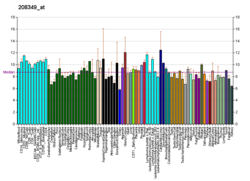Transient receptor potential cation channel, subfamily A, member 1, also known as transient receptor potential ankyrin 1, TRPA1, or The Mustard and Wasabi Receptor, is a protein that in humans is encoded by the TRPA1 (and in mice and rats by the Trpa1) gene.[5][6]
TRPA1 is an ion channel located on the plasma membrane of many human and animal cells. This ion channel is best known as a sensor for pain, cold and itch in humans and other mammals, as well as a sensor for environmental irritants giving rise to other protective responses (tears, airway resistance, and cough).[7][8]
- ^ a b c GRCh38: Ensembl release 89: ENSG00000104321 – Ensembl, May 2017
- ^ a b c GRCm38: Ensembl release 89: ENSMUSG00000032769 – Ensembl, May 2017
- ^ "Human PubMed Reference:". National Center for Biotechnology Information, U.S. National Library of Medicine.
- ^ "Mouse PubMed Reference:". National Center for Biotechnology Information, U.S. National Library of Medicine.
- ^ Jaquemar D, Schenker T, Trueb B (March 1999). "An ankyrin-like protein with transmembrane domains is specifically lost after oncogenic transformation of human fibroblasts". The Journal of Biological Chemistry. 274 (11): 7325–33. doi:10.1074/jbc.274.11.7325. PMID 10066796.
- ^ Clapham DE, Julius D, Montell C, Schultz G (December 2005). "International Union of Pharmacology. XLIX. Nomenclature and structure-function relationships of transient receptor potential channels". Pharmacological Reviews. 57 (4): 427–50. doi:10.1124/pr.57.4.6. PMID 16382100. S2CID 17936350.
- ^ Andersen HH, Elberling J, Arendt-Nielsen L (September 2015). "Human surrogate models of histaminergic and non-histaminergic itch". Acta Dermato-Venereologica. 95 (7): 771–7. doi:10.2340/00015555-2146. PMID 26015312.
- ^ Højland CR, Andersen HH, Poulsen JN, Arendt-Nielsen L, Gazerani P (September 2015). "A human surrogate model of itch utilizing the TRPA1 agonist trans-cinnamaldehyde" (PDF). Acta Dermato-Venereologica. 95 (7): 798–803. doi:10.2340/00015555-2103. PMID 25792226. S2CID 10418526.





